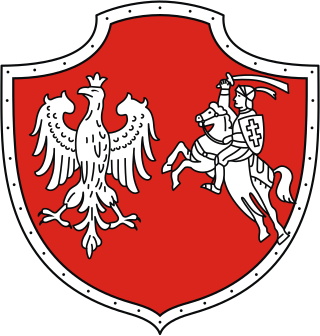
The national flag of Poland consists of two horizontal stripes of equal width, the upper one white and the lower one red. The two colours are defined in the Polish constitution as the national colours. A variant of the flag with the national coat of arms in the middle of the white fess is legally reserved for official use abroad and at sea. A similar flag with the addition of a white eagle is used as the naval ensign of Poland.

The Polish–Soviet War was primarily fought between the Second Polish Republic and the Russian Soviet Federative Socialist Republic in the aftermath of World War I and the Russian Revolution, on territories which were formerly held by the Russian Empire and the Austro-Hungarian Empire.

The Republic of Central Lithuania, commonly known as the Central Lithuania, and the Middle Lithuania, was an unrecognized short-lived puppet republic of Poland, that existed from 1920 to 1922. It was founded on 12 October 1920, after Żeligowski's Mutiny, when soldiers of the Polish Army, mainly the 1st Lithuanian–Belarusian Infantry Division under Lucjan Żeligowski, fully supported by the Polish air force, cavalry and artillery, attacked Lithuania. It was incorporated into Poland on 18 April 1922.

The national emblem of Belarus features a ribbon in the colors of the national flag, a silhouette of Belarus, wheat ears and a red star. It is sometimes referred to as the coat of arms of Belarus, although in heraldic terms this is inaccurate as the emblem does not respect the rules of conventional heraldry. The emblem is an allusion to one that was used by the Byelorussian SSR, designed by Ivan Dubasov in 1950, with the biggest change being a replacement of the Communist hammer and sickle with a silhouette of Belarus. The Belarusian name is Dziaržaŭny herb Respubliki Biełaruś, and the name in Russian is Gosudarstvennyĭ gerb Respubliki Belarusʹ.

The coat of arms of Lithuania is a mounted armoured knight holding a sword and shield, known as Vytis. Since the early 15th century, it has been Lithuania's official coat of arms and is one of the oldest European coats of arms. It is also known by other names in various languages, such as Waykimas, Pagaunė in the Lithuanian language or as Pogonia, Pogoń, Пагоня in the Polish, and Belarusian languages. Vytis is translatable as Chase, Pursuer, Knight or Horseman, similar to the Slavic vityaz. Historically – raitas senovės karžygys or in heraldry – raitas valdovas.

The coat of arms of Poland is a white, crowned eagle with a golden beak and talons, on a red background.

The coat of arms that serves as the symbol of the Lublin Voivodeship, Poland depicts a white (silver) male jumping cervus (deer), with a yellow (golden) crown on its neck, placed on a red background. The current design of the coat of arms was designed by Andrzej Heidrich, and adopted in 2002.

The War Order of Virtuti Militari is Poland's highest military decoration for heroism and courage in the face of the enemy at war. It was created in 1792 by Polish King Stanislaus II Augustus and is the oldest military decoration in the world still in use.

Throughout most of the history of Poland, the banner of Poland was one of the main symbols of the Polish State, normally reserved for use by the head of state. Although its design changed with time, it was generally a heraldic banner, i.e., one based directly on the national coat of arms: a crowned White Eagle on a red field. The banner should not be confused with the flag of Poland, a white and red horizontal bicolor, officially adopted in 1919.

Żeligowski's Mutiny was a Polish false flag operation led by General Lucjan Żeligowski in October 1920, which resulted in the creation of the Republic of Central Lithuania. Polish Chief of State Józef Piłsudski surreptitiously ordered Żeligowski to carry out the operation, and revealed the truth only several years afterwards. The area was formally annexed by Poland in 1922 and recognized by the Conference of Ambassadors as Polish territory in 1923. The decision was not recognized by Lithuania, which continued to claim Vilnius and the Vilnius Region, and by the Soviet Union.
Upon the independence of Belarus from the Soviet Union, the country resurrected national symbols that were used before the Soviet era. These included a flag of red and white stripes and a coat of arms consisting of a charging knight on horseback. These national symbols were replaced by Soviet-era symbols in a disputed 1995 vote. Those two symbols, along with the national anthem, are the constitutionally defined national symbols of Belarus.

10th Lithuanian Uhlan Regiment was a cavalry unit of the Polish Army in the Second Polish Republic. From 1922 until 1939, it was garrisoned in Białystok. The regiment was created as part of the so-called Lithuanian and Belarusian Self-Defence. Also, in 1920 - 1922, it belonged to the armed forces of the Republic of Central Lithuania. During the Invasion of Poland, it was part of Podlaska Cavalry Brigade.

The coat of arms that serves as the official symbol of the Masovian Voivodeship, Poland, consists of a red escutcheon, that features a white (silver) eagle, with raised wings, and its head turned left. Its current version had been designed by Andrzej Heidrich, and adopted in 2006.

The Ruthenian lion, Ukrainian (Russiae) lion, or Halychian (Galician) lion is a golden lion on an azure background. The lion was featured on the historic coat of arms of the Kingdom of Rus, the Ruthenian Voivodeship and the Western Ukrainian People's Republic. During the revolutions in the Austrian Empire in 1848, it became one of the national symbols of Ukrainians and the Ukrainian national liberation movement. Today it is featured on the coat of arms of the city of Lviv and its surrounding province, Lviv Oblast.

The coat of arms of the Republic of Central Lithuania, an unrecognized short-lived puppet republic of Poland, was established on 12 October 1920 and remained in use until 18 April 1922, when the state ceased to exist.

The Provisional Governing Commission was a provisional executive government of the Republic of Central Lithuania, that existed from 1920 to 1922.

The white-red-white flag is a historic flag used by the Belarusian Democratic Republic in 1918 before Western Belarus was occupied by the Second Polish Republic and Eastern Belarus was occupied by Soviet Union. The flag was then used by the Belarusian national movement in Western Belarus followed by widespread unofficial use during the German occupation of Belarus between 1941 and 1944, and again after it regained its independence in 1991 until the 1995 referendum.

The coat of arms of the Łódź Voivodeship, Poland is an Iberian-style escutcheon with square top and rounded base. It is divided horizontally into three stripes (pales), that area from left to right: yellow (golden), red, and yellow (red), with the middle stripe being twice as big as the other stripes. It also include three charges placed in its center, with two placed next to each over, on the top of the third one. The top two charges are Kuyavian Hybrids, divided into half, into a lion and an eagle, while the bottom one is an eagle. It was designed by Marek Adamczewski, and officially adopted on 25 June 2002.

The Cross of Merit of the Army of Central Lithuania was a military order of merit awarded by the Republic of Central Lithuania in 1922, and by the Second Polish Republic, from 1922 to 1926. It was awarded to the soldiers of the Polish Armed Forces, and the Army of Central Lithuania, in recognition of merit, expressed by the soldiers during the war Polish–Lithuanian War, from 9 October to 19 November 1920, which included the Żeligowski's Mutiny, and the Central Lithuanian Offensive on Kaunas.

The coat of arms that serves as the symbol of the Podlaskie Voivodeship, Poland is divided into two horizontal red fields. The top field depicts a white eagle, and a bottom field, a knight in a white (silver) armor, sitting on a white (silver) horse with a blue saddle and shabrack, and yellow (golden) harness, standing on its back hoofs. The knight has a blue shield with a yellow (golden) cross of Lorraine on it, put on his left arm, and hold a sword in his right hand. The current design of the coat of arms was designed by Tadeusz Gajl, and adopted in 2001.


















